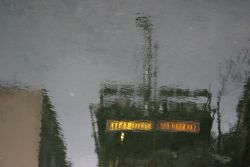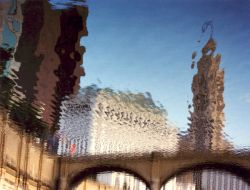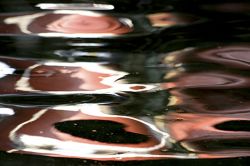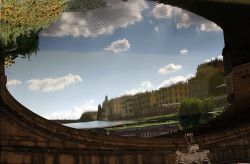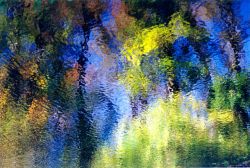
Dec, 13, 2003
Daily Camera, Boulder
Seeing Red
written by Lisa Marshall

Cello Music by Marcia Smilack
For people with synthesthesia, sound has color and music has shape
SEEING RED
By Lisa Marshall, Camera Staff Writer
December 14, 2003
To Massachusetts photographer Marcia Smilack, the image of light
reflecting on water makes an almost deafening musical crescendo.
To New York painter Carol Steen, pain appears orange.
To Boulder poet Clara Burns, a year is an exaggerated oval, a
"bent race track," and each month is a colored rectangle within
it.
Confused?
While these may sound like mere metaphors hatched in the fertile
imaginations of artists, they are in fact true sensory experiences,
says psychologist Peter Grossenbacher, head of the Consciousness
Laboratory at Naropa University and one of the nation's leading experts
in synesthesia.
The little-known neurological trait (only recently acknowledged
as real in the scientific community) causes as many as 1 in 300 people
to have their perceptual wires crossed, leading them to respond to
outside stimuli with one sense instead of or in addition to the
expected one. Some so-called "synesthetes" literally see sounds and
hear colors. Others taste shapes and feel images. Many, like Burns,
perceive time as having shape and numbers and letters as having their
own specific colors.
"For them, the experience is so real. A scent may be smelled and
heard. It has its own loudness, pitch and timbre. Or the sound of an
electric guitar may induce one specific color," says Grossenbacher, who
has a Ph.D. and spent five years studying synesthesia at the National
Institutes of Mental Health before coming to Boulder three years
ago.
While reports of "colored hearing" and "colored letters" date
back to the early 1800s, synesthesia was long written off as the
product of artistic fancy, psychedelic drugs or madness. But in the
past decade, thanks to brain scan technology that now allows scientists
to spy on the brain as it experiences the senses, researchers have
begun to acknowledge that the condition may be real and investigate
what causes it.
Perhaps, some researchers say, the brains of synesthetes are
structurally different, with portions of the brain that control color
signals and hearing, for instance, so close together that signals
intended for one area hit both. Or perhaps, as Grossenbacher thinks,
people have the same basic neurological wiring, but in most of us,
hormones keep us from experiencing those extra sensory perceptions so
we don't get confused.
"There are people who never experience synesthesia until they
take LSD," he notes. Because people don't suddenly grow new anatomical
connections in their brains when they take drugs, he's convinced we all
have the same neurological connections, but for some reason synesthetes
use theirs more fully.
The trait is worth studying, researchers say, because it may
offer insight into why some people are naturally more artistically
inclined or more easily overstimulated than others. And perhaps, some
theorize, those who lose one sense due to a brain injury may be able to
compensate through synesthesia.
For those who have it and never knew it had a name, the brewing
interest has been a blessing because it has brought them
together.
Being different
"People with synesthesia just think that everyone is perceiving
what they are perceiving until one day, they say something by accident
and they realize that is not the case," says Pat Duffy, co-founder of
the American Synesthesia Association and author of "Blue Cats and
Chartreuse Kittens; How Synesthetes Color Their Worlds," (Henry Holt;
2001) "It can make you feel kind of strange and alone."
To Duffy, the letter A has always been orange in her mind's eye
and the letter C has always been blue. Time has always had shape and
color.
It never dawned on her that others didn't see things the same
until age 16, when she was reminiscing with her dad about when she was
learning to write the letters P and R.
"I said to my father, 'I was so surprised that I could turn a
yellow letter into an orange letter just by adding a line," she
recalls.
Understandably, he was puzzled.
Years later, she came across an article written by one of
Grossenbacher's colleagues, and learned that her visions of colored
numbers had a name.
Soon, she was seeking out other synesthetes around the country so she could share their story in a book.
Steen was one of them.
The New York painter and sculptor was 7 when she first realized she may be different.
"I was walking home from elementary school in Detroit and I
turned to my girlfriend and said, 'You know, the letter A is the
prettiest pink I've ever seen," recalls Steen. "She gave me one of
those withering looks and said, 'You are really weird.' I didn't say
another word about it until I was 20. I didn't want to be weird."
In 1995, she helped Duffy found the American Synesthesia Association.
It now has 150 members and has held several national conferences at prestigious universities.
Steen, known for her vivid paintings of the color of touch, now
lectures and writes academic papers about her experiences as a
synesthetic artist. The ASA Web site serves to bring synesthetes from
across the country together.
"It has completely shaped my life, now that I know I have it," Steen says.
Artistic link
So far, research has shown that synesthesia is hereditary, and
more common among women and children. But new research is suggesting
another not-so-surprising trend. It is far more prevalent among
artists.
Out of 84 synesthetes Grossenbacher interviewed this fall for a
study, 26 turned out to be professional artists, writers or musicians
and 44 spent much of their free time pursuing the arts.
Another study, cited in an April article in Scientific American
found that the condition was seven times more common among artists than
in the general public:
"Our insights into the neurological basis of synesthesia could
help explain some of the creativity of painters, poets and novelists,"
wrote Vilayanur S. Ramachandran, director of the Center for Brain and
Cognition at the University of California at San Diego.
In her book, Duffy points out that many famous artists over the centuries have touted themselves as synesthetic:
Nineteenth-century French poet Arthur Rimbaud wrote about seeing
colored vowels; Russian writer Vladimir Nabokov described his own
colored alphabet in his autobiography; composers Frank Liszt and
Olivier Messiaen both reported seeing colored musical notes. Painter
David Hockney paints with the colors he sees when listening to
music.
"It makes sense," says Duffy. "You have this very active inner life, and you want to express it."
Massachusetts photographer Marcia Smilack says she could not practice her unique art without her synesthesia.
"I consider it a gift. Everyone I have ever known considers it a gift," she says.
She has a doctorate in English literature but earns her living as
a "reflectionist" photographing almost exclusively reflections on
water. When the light hits the water, she literally hears music.
"I shoot when I hear a chord of color," she says.
Scientific evidence
While such stories may seem hard to believe, modern science is beginning to lend credibility to them.
At last month's Society for Neuroscience meeting in New Orleans,
researchers from the United States and Europe shared their recent
findings on synesthesia.
In one study a team of scientists at Oxford University
interviewed people who said they had experienced colored hearing all
their lives. They were asked to describe what colors they saw when
hearing the names of each day of the week, month of the year, and
letter of the alphabet and of several numbers between one and 100. Two
months later, they were surprised with another, identical pop
quiz.
Their answers were, for the most part, the same.
"This is strong evidence that they were experiencing a genuine
phenomenon. They actually appeared to be seeing colors in their mind's
eye," said Megan Steven, the lead author of the study, in a prepared
statement. Even more impressive: the subjects had all been blind for at
least 10 years.
In another study, which Ramachandran describes in the Scientific
American article, synesthetes were asked to look at a set of black 2s
in the shape of a triangle, hidden in a sea of black 5s. To most
viewers, it would be hard to distinguish the 2s from the 5s and the
black-and-white sea. But for synesthetes, for whom 2s and 5s are
different colors, the triangle of 2s popped out immediately.
In another experiment using brain imaging techniques, synesthetes
presented with a sequence of numbers showed activity in not only the
portion of the brain that processes numbers, but also the one that
processes color.
And the researchers are just getting started, Grossenbacher says.
He has been in contact with more than 400 synesthetes across the nation and hopes to interview as many as possible.
He says better understanding the trait may help prevent those who have it from being misunderstood.
"I had one woman who, as a teen, was sent to drug rehab after a
teacher overheard her describing something she had seen," he said.
Another was placed on medication to treat what her doctor perceived as
hallucinations.
Duffy is delighted to, at last, be connecting with others like her around the country.
But she thinks her neurological quirk is just one example of how
differently human beings ‹ synesthetic or not ‹ can perceive the world
around them.
"Anytime any of us looks at the world, we are seeing it as no one
else has seen it before. We are seeing it through a lens that no one
else," she says. "Maybe synesthesia just gives us a very concrete
example of that."
